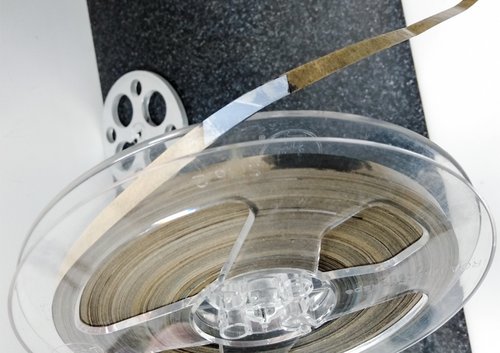
By Grant McBride
I’ve been working with the T-Series – our Radio New Zealand (RNZ) collection of reel-to-reel tapes. The ‘T’ simply stands for Tape. This collection contains a whole range of items, from on-air programs taken from RNZ (think Insight, Profiling NZ Music, etc) to political speeches, advertisements – you name it.
Most of the collection is stored on standard polyester or acetate tape but occasionally you come across more unique content. I worked on two such tapes last week – one from 1954 rather expansively titled Interview with Mrs Comrie, who embroidered a petit-point tapestry of Mount Cook for Queen Elizabeth . The other was a spliced together selection of audio seemingly from various events in Timaru, including the opening of Timaru airport in 1953 and a lively excerpt from It's in the Bag , with Selwyn Toogood. These are some of the oldest titles in our tape collection.
Both of these tapes were paper-based. That’s right – paper. It’s an extremely fragile format and difficult to preserve. It’s very fibrous, quite like the standard pages of older hardcover books. There is a magnetic strip bound to one side of the paper that allows the reel-to-reel tape machine to read the audio data. As the paper is so fragile, the magnetic strip layer comes apart quite easily.
To preserve them, first the tape needed to be unwound from its metal reel (which also needed to be replaced) to check on its condition. This was not quite as simple as it sounds, as the tape had originally been cut and spliced with cellotape. This is non-archival and the cellotape had heavily degraded. Due to the porous nature of paper, the binding layer of the cellotape had soaked through each subsequent layer of tape – sticking the entire thing together. Each layer of tape on the reel had to be unwound and very carefully separated – often resulting in the cuts coming apart and needing to be repaired with more modern splicing tape (which is less prone to degradation). This process took around three hours per tape. Quite the task for an assumed 20 minutes of audio!
Hero image: A paper-based reel-to-reel audio tape - white cellotape was used to splice cuts together, but it has degraded over time and sticky cellotape residue has left a dark patch below where this section would sit on the reel. (Photo by Grant McBride)

Paper-based tape running through the reel-to-reel machine (Photo by Grant McBride)
The next challenge was actually playing the tape back in order to get it digitised. As they were incredibly fragile, both tapes were prone to breaking, seemingly for no reason in the middle of recording. When this happened (as it did about 10-15 times per recording session), I needed to pause the recording and quickly repair and/or re-splice the tape where it had broken, rewind it back to around 10 seconds before the breakage had occurred, and continue recording. The reel-to-reel machine was connected to my computer and once the audio was digitally captured in its entirety, I went back over it using Wavelab, our audio editor programme. I repaired the errors, stitching the pieces together in natural pauses (such as when the speaker takes a breath). All in all, the process took around eight hours to complete, but both tapes are now preserved and digitised in their entirety.
A little something extra...
Former broadcaster and sound archivist (and newsletter reader) Peter Downes got in touch about this article to share his recollections of paper tape:
“I am amazed that examples of paper-tape recording have survived – and what memories they have brought back. I well recall using paper-based recording tape at NZBS in the early 1950s. It was first on the tape-recording scene and seemed a near miracle in that it could be cut-edited, though v-e-r-y carefully. It had a real problem, though, in that the tape was likely to tear and/or break during recording or after. Rewinding was a nightmare. To avoid a tear or break it had to be rewound slowly.
Once audio had been recorded it was transferred as soon as possible onto an acetate disc for broadcast use and later storage. When plastic-based tape became available the tear/break problem was, well I was going to say cured, but the new tape was also known to break, but only very rarely, so the immediate copying to acetate discs was continued for a while. We weren’t confident that it wouldn’t have the same problem. We were soon converted and recording on tape became the norm. What a blessing it was.
One further memory of the introduction of recording on tape. Very early on some studio artists were wary of the new technology. They said they couldn’t see the actual recording whereas on discs they could see the grooves. They too, were soon converted when they learned they could make mistakes and not have to repeat a whole work from the beginning.”
For more on this subject, listen to 'Preserving Timaru sound history recorded on paper' on RNZ with Sarah Johnston and Jesse Mulligan.